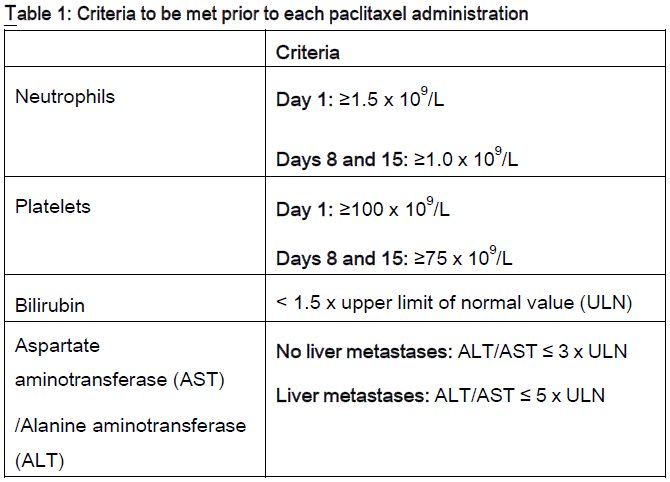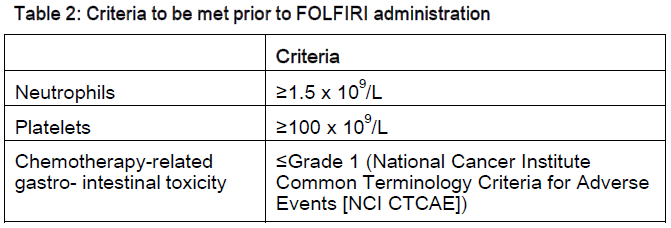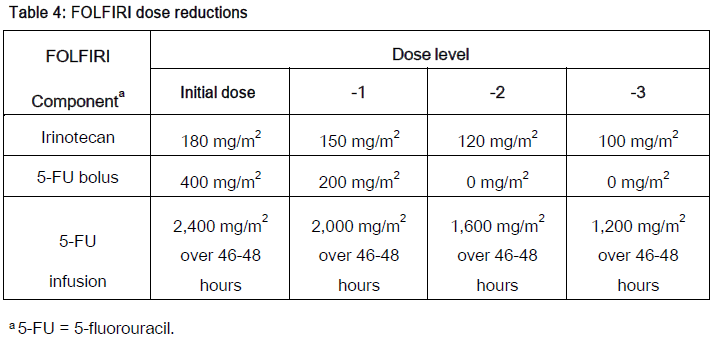Regulatory Information
HSA regulatory responsibility and product classification details
Regulatory Responsibility
Product Classification
Formulation Information
INJECTION, SOLUTION, CONCENTRATE
**4.2 Posology and method of administration** Cyramza therapy must be initiated and supervised by physicians experienced in oncology. Posology _Gastric cancer and gastro-oesophageal junction (GEJ) adenocarcinoma_ _Cyramza in combination with paclitaxel_ The recommended dose of Cyramza is 8 mg/kg on days 1 and 15 of a 28 day cycle, prior to paclitaxel infusion. The recommended dose of paclitaxel is 80 mg/m2 administered by intravenous infusion over approximately 60 minutes on days 1, 8 and 15 of a 28 day cycle. Prior to each paclitaxel infusion, patients should have a complete blood count and blood chemistry performed to evaluate hepatic function. Criteria to be met prior to each paclitaxel infusion are provided in Table 1.  _Cyramza as a single agent_ The recommended dose of Cyramza as a single agent is 8 mg/kg every 2 weeks. _Non-Small Cell Lung Cancer (NSCLC)_ _Cyramza in combination with erlotinib for the treatment of NSCLC with activating EGFR mutations_ The recommended dose of Cyramza in combination with erlotinib is 10 mg/kg every two weeks. EGFR mutation status should be determined prior to initiation of treatment with Cyramza and erlotinib using a validated test method. See erlotinib prescribing information for the posology and method of administration of erlotinib. _Cyramza in combination with docetaxel for the treatment of NSCLC after platinum-based chemotherapy_ The recommended dose of Cyramza is 10 mg/kg on day 1 of a 21 day cycle, prior to docetaxel infusion. The recommended dose of docetaxel is 75 mg/m2 administered by intravenous infusion over approximately 60 minutes on day 1 of a 21 day cycle. See docetaxel prescribing information for specific dosing advice. _Colorectal cancer_ The recommended dose of Cyramza is 8 mg/kg every 2 weeks administered by intravenous infusion, prior to FOLFIRI administration. Prior to chemotherapy, patients should have a complete blood count. Criteria to be met prior to FOLFIRI are provided in Table 2.  _Hepatocellular carcinoma (HCC)_ The recommended dose of Cyramza as a single agent is 8 mg/kg every 2 weeks. _Alpha fetoprotein (AFP) testing in HCC_ Patients with HCC should be selected based on a serum AFP concentration of ≥ 400 ng/ml with a validated AFP test prior to Cyramza treatment (see section 5.1 – _please refer to the Product Insert/Patient Information Leaflet published on HSA for the full drug information_). _Duration of treatment_ It is recommended that treatment be continued until disease progression or until unacceptable toxicity has occurred. _Premedication_ Premedication is recommended with a histamine H1 antagonist (for example diphenhydramine) prior to infusion of Cyramza. If a patient experiences a Grade 1 or 2 infusion-related reaction premedication must be given for all subsequent infusions. If a patient experiences a second Grade 1 or 2 infusion-related reaction (IRR) administer dexamethasone (or equivalent); then, for subsequent infusions, premedicate with the following or equivalent medicinal products: an intravenous histamine H1 antagonist (for example diphenhydramine hydrochloride), paracetamol and dexamethasone. See prescribing information for paclitaxel, for components of FOLFIRI and for docetaxel, as applicable, for premedication requirements and additional information. _Posology adjustments for Cyramza_ _Infusion-related reactions_ The infusion rate of Cyramza should be reduced by 50% for the duration of the infusion and all subsequent infusions if the patient experiences a grade 1 or 2 IRR. Cyramza should be immediately and permanently discontinued in the event of a grade 3 or 4 IRR (see section 4.4 – _please refer to the Product Insert/Patient Information Leaflet published on HSA for the full drug information_). _Hypertension_ The blood pressure of patients should be monitored prior to each Cyramza administration and treated as clinically indicated. Cyramza therapy should be temporarily discontinued in the event of severe hypertension, until controlled with medical management. If there is medically significant hypertension that cannot be controlled safely with antihypertensive therapy, Cyramza therapy should be permanently discontinued (see section 4.4 – _please refer to the Product Insert/Patient Information Leaflet published on HSA for the full drug information_). _Proteinuria_ Patients should be monitored for the development, or worsening of proteinuria during Cyramza therapy. If the urine protein is ≥ 2+ on a dipstick, a 24 hour urine collection should be performed. Cyramza therapy should be temporarily discontinued if the urine protein level is ≥ 2 g/24 hours. Once the urine protein level returns to < 2 g/24 hours, treatment should be resumed at a reduced dose level (see Table 3). A second dose reduction (see Table 3) is recommended if a urine protein level ≥ 2 g/24 hours reoccurs. Cyramza therapy should be permanently discontinued if the urine protein level is > 3g/ 24 hours or in the event of nephrotic syndrome.  _Elective surgery or impaired wound healing_ Cyramza therapy should be temporarily discontinued for at least 4 weeks prior to elective surgery. Cyramza therapy should be temporarily discontinued if there are wound healing complications, until the wound is fully healed (see section 4.4 – _please refer to the Product Insert/Patient Information Leaflet published on HSA for the full drug information_). _Permanent discontinuation_ Cyramza therapy should be permanently discontinued in the event of: - Severe arterial thromboembolic events (see section 4.4 – _please refer to the Product Insert/Patient Information Leaflet published on HSA for the full drug information_). - Gastrointestinal perforations (see section 4.4 – _please refer to the Product Insert/Patient Information Leaflet published on HSA for the full drug information_). - Severe bleeding: NCI CTCAE Grade 3 or 4 bleeding (see section 4.4 – _please refer to the Product Insert/Patient Information Leaflet published on HSA for the full drug information_). - Spontaneous development of fistula (see section 4.4 – _please refer to the Product Insert/Patient Information Leaflet published on HSA for the full drug information_). - Hepatic encephalopathy or hepatorenal syndrome (see section 4.4 – _please refer to the Product Insert/Patient Information Leaflet published on HSA for the full drug information_). _Paclitaxel dose adjustments_ Paclitaxel dose reductions may be applied based upon the grade of toxicity experienced by the patient. For NCI CTCAE Grade 4 haematological toxicity or Grade 3 paclitaxel-related non-haematological toxicity, it is recommended to reduce the paclitaxel dose by 10 mg/m2 for all following cycles. A second reduction of 10 mg/m2 is recommended if these toxicities persist or reoccur. _FOLFIRI dose adjustments_ Dose reductions for individual components of FOLFIRI may be made for specific toxicities. Dose modifications of each component of FOLFIRI should be made independently and are provided in Table 4. Table 5 provides details of dose delays or dose reductions of components of FOLFIRI at the next cycle based on maximum grade of specific adverse drug reactions.   _Docetaxel dose adjustments_ Docetaxel dose reductions may be applied based upon the grade of toxicity experienced by the patient. Patients who experience either febrile neutropenia, neutrophils < 500 cells/mm3 for more than 1 week, severe or cumulative cutaneous reactions, or other Grade 3 or 4 non-haematological toxicities during docetaxel treatment should have treatment withheld until resolution of the toxicity. It is recommended to reduce the docetaxel dose by 10 mg/m2 for all following cycles. A second reduction of 15 mg/m2 is recommended if these toxicities persist or reoccur. _Special populations_ _Elderly_ In the pivotal studies there is limited evidence that patients 65 years of age or older are at increased risk of adverse events compared to patients younger than 65 years old. No dose reductions are recommended (see sections 4.4 and 5.1 – _please refer to the Product Insert/Patient Information Leaflet published on HSA for the full drug information_). _Renal impairment_ There have been no formal studies with Cyramza in patients with renal impairment. Clinical data suggest that no dose adjustments are required in patients with mild, moderate or severe renal impairment (see sections 4.4 and 5.2 – _please refer to the Product Insert/Patient Information Leaflet published on HSA for the full drug information_). No dose reductions are recommended. _Hepatic impairment_ There have been no formal studies with Cyramza in patients with hepatic impairment. Clinical data suggest that no dose adjustments are required in patients with mild or moderate hepatic impairment. There are no data regarding Cyramza administration in patients with severe hepatic impairment (see sections 4.4 and 5.2 – _please refer to the Product Insert/Patient Information Leaflet published on HSA for the full drug information_). No dose reductions are recommended. _Paediatric population_ The safety and efficacy of Cyramza in children and adolescents (< 18 years) has not been established. Currently available data are described in section 4.8, 5.1 and 5.2 – _please refer to the Product Insert/Patient Information Leaflet published on HSA for the full drug information_. Due to limited data no recommendation on posology can be made. There is no relevant use of Cyramza in the paediatric population for the indications of advanced gastric cancer or gastro-oesophageal adenocarcinoma, adenocarcinoma of the colon and rectum, lung carcinoma and hepatocellular carcinoma. Method of administration Cyramza is for intravenous use. After dilution, Cyramza is administered as an intravenous infusion over approximately 60 minutes. It should not be administered as an intravenous bolus or push. To achieve the required infusion duration of approximately 60 minutes, the maximum infusion rate of 25 mg/minute should not be exceeded, instead the infusion duration should be increased. The patient should be monitored during infusion for signs of infusion-related reactions (see section 4.4 – _please refer to the Product Insert/Patient Information Leaflet published on HSA for the full drug information_) and the availability of appropriate resuscitation equipment should be ensured. For instructions on dilution of the medicinal product before administration, see section 6.6 – _please refer to the Product Insert/Patient Information Leaflet published on HSA for the full drug information_.
INTRAVENOUS
Medical Information
**4.1 Therapeutic indications** Gastric cancer Cyramza as a single agent or in combination with paclitaxel, is indicated for the treatment of adult patients with advanced or metastatic, gastric or gastro-oesophageal junction adenocarcinoma, with disease progression on or after prior fluoropyrimidine- or platinum-containing chemotherapy. Non-small cell lung cancer (NSCLC) Cyramza in combination with erlotinib is indicated for the first-line treatment of adult patients with metastatic non-small cell lung cancer with activating epidermal growth factor receptor (EGFR) mutations (see section 5.1 – _please refer to the Product Insert/Patient Information Leaflet published on HSA for the full drug information_). Cyramza in combination with docetaxel, is indicated for the treatment of adult patients with locally advanced or metastatic NSCLC with disease progression on or after platinum based chemotherapy. Colorectal cancer Cyramza in combination with FOLFIRI (irinotecan, folinic acid, and 5-fluorouracil), is indicated for the treatment of adult patients with metastatic colorectal cancer (mCRC) with disease progression on or after prior therapy with bevacizumab, oxaliplatin and a fluoropyrimidine. Hepatocellular carcinoma (HCC) Cyramza monotherapy is indicated for the treatment of adult patients with advanced or unresectable HCC who have a serum alpha fetoprotein (AFP) of ≥ 400 ng/ml and who have been previously treated with sorafenib.
**4.3 Contraindications** Hypersensitivity to the active substance or to any of the excipients listed in section 6.1 – _please refer to the Product Insert/Patient Information Leaflet published on HSA for the full drug information_. For patients with NSCLC, Cyramza is contraindicated where there is tumour cavitation or tumour involvement of major vessels (see section 4.4 – _please refer to the Product Insert/Patient Information Leaflet published on HSA for the full drug information_).
L01XC21
xl 01 xc 21
Manufacturer Information
DKSH SINGAPORE PTE. LTD.
Eli Lilly and Company
LILY FRANCE-FEGERSHEIM
Active Ingredients
Documents
Package Inserts
Cyramza PI.pdf
Approved: March 14, 2023
